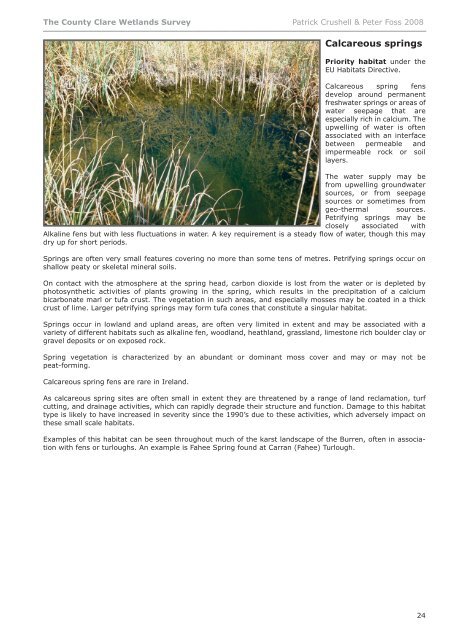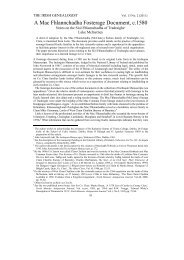Report Cover Vol I - Clare County Library
Report Cover Vol I - Clare County Library
Report Cover Vol I - Clare County Library
You also want an ePaper? Increase the reach of your titles
YUMPU automatically turns print PDFs into web optimized ePapers that Google loves.
The <strong>County</strong> <strong>Clare</strong> Wetlands Survey Patrick Crushell & Peter Foss 2008<br />
___________________________________________________________<br />
Calcareous springs<br />
Priority habitat under the<br />
EU Habitats Directive.<br />
Calcareous spring fens<br />
develop around permanent<br />
freshwater springs or areas of<br />
water seepage that are<br />
especially rich in calcium. The<br />
upwelling of water is often<br />
associated with an interface<br />
between permeable and<br />
impermeable rock or soil<br />
layers.<br />
The water supply may be<br />
from upwelling groundwater<br />
sources, or from seepage<br />
sources or sometimes from<br />
geo-thermal sources.<br />
Petrifying springs may be<br />
closely associated with<br />
Alkaline fens but with less fluctuations in water. A key requirement is a steady flow of water, though this may<br />
dry up for short periods.<br />
Springs are often very small features covering no more than some tens of metres. Petrifying springs occur on<br />
shallow peaty or skeletal mineral soils.<br />
On contact with the atmosphere at the spring head, carbon dioxide is lost from the water or is depleted by<br />
photosynthetic activities of plants growing in the spring, which results in the precipitation of a calcium<br />
bicarbonate marl or tufa crust. The vegetation in such areas, and especially mosses may be coated in a thick<br />
crust of lime. Larger petrifying springs may form tufa cones that constitute a singular habitat.<br />
Springs occur in lowland and upland areas, are often very limited in extent and may be associated with a<br />
variety of different habitats such as alkaline fen, woodland, heathland, grassland, limestone rich boulder clay or<br />
gravel deposits or on exposed rock.<br />
Spring vegetation is characterized by an abundant or dominant moss cover and may or may not be<br />
peat-forming.<br />
Calcareous spring fens are rare in Ireland.<br />
As calcareous spring sites are often small in extent they are threatened by a range of land reclamation, turf<br />
cutting, and drainage activities, which can rapidly degrade their structure and function. Damage to this habitat<br />
type is likely to have increased in severity since the 1990’s due to these activities, which adversely impact on<br />
these small scale habitats.<br />
Examples of this habitat can be seen throughout much of the karst landscape of the Burren, often in association<br />
with fens or turloughs. An example is Fahee Spring found at Carran (Fahee) Turlough.<br />
24
















